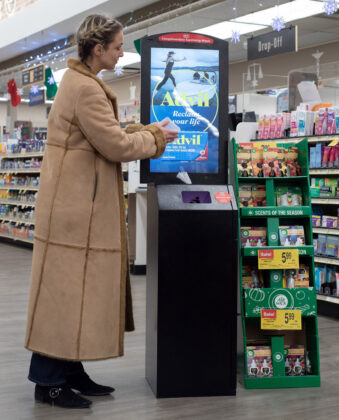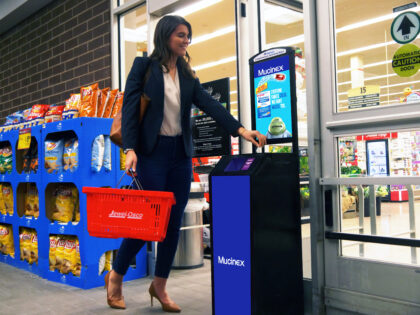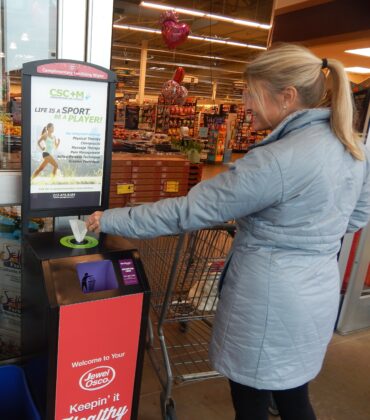The best marketing strategies find ways to reach consumers when they are about to make a purchase decision and are most open to being influenced.
This is an area in which point-of-sale advertising (POS) excels, especially with the use of grocery store promotions, so let’s break down the top strategies for deploying a POS campaign.
What’s Point Of Sale Advertising?
Point of sale advertising describes marketing displays that are located near where customers pay for products. POS can provide a massive boost in sales since it catches consumers when they are making a purchase decision and encourages impulse buying.
Effective Point of Sale Strategies
In-store signage and displays
This is the format most people imagine when they think of point-of-sale advertising and includes signs and banners located next to a register. These displays, along with physical retail promotion, are great for selling small items such as snacks or small accessories like batteries.
While static signs and banners have always been the norm, many marketing strategies also incorporate video walls, digital screens, and interactive elements like QR codes. This can help all brands make the most of displays located next to checkout locations, even those that don’t necessarily sell small items.
Wellness boards
Wellness boards offer shoppers sanitizing wipes from a dispenser located below a prominently featured digital or non-digital advertisement. Sanitizing kiosks located near points of sale are known to drive impressive levels of engagement since shoppers generally appreciate a wipe after touching various store items and carts.
Research has shown that the most successful marketing strategies create a memorable connection with consumers by appealing to one or more of their five senses. Wellness boards make fostering this connection easy as they appeal to the sense of touch with their sanitizing wipes and sight with eye-catching ad content.
Terraboost is a leader in this advertising medium and has delivered impressive results for its partnered brands. Independent studies found that 80% of shoppers take a wipe from their sanitizing kiosks and 50% take a coupon or brochure to learn more.
Sampling and Demonstrations
Demo stations can be a great way to drive sales in a POS marketing campaign. These demo stations can either provide samples to consumers or show them how to properly use a featured product.
You will want to position sampling and demonstrations as close to checkout counters as possible without overcrowding the area. Offering snacks close to points of sale is an easy way to encourage impulse purchases as consumers usually don’t mind adding one more item to the cart, especially if it’s a tasty treat.
Audio Advertising
Retailers have always used sound systems to broadcast announcements or play upbeat music throughout the store. However, sound systems are now being used to provide point-of-sale advertisements that give consumers a final nudge toward buying a product.
What’s great about audio advertising is that you have a captive audience that can’t help engaging with the content. It may be easy to look the other way or ignore displays and signage, but it’s quite difficult not to listen to an audio promotion.
If these advertisements are created with enough creativity, they have great potential to win over shoppers. For example, beverage company Twisted Tea launched an audio advertising campaign that satirically imitated an employee announcement and told shoppers to meet in the alcohol aisle.
Mobile Point of Sale Advertising
Nowadays, basically every consumer is walking into the store with a smartphone. Some retailers are making the most of this and letting shoppers use their mobile devices to process sales.
Mobile point-of-sale systems allow big retailers and small businesses alike to accept payments away from the checkout line. These mobile payment systems can benefit retailers since they let you track consumer information and other data. Plus, mobile payment systems make it easy to deliver personalized offers and loyalty rewards programs to repeat shoppers.
Using Digital Strategies
There are a variety of digital strategies and advertising formats that can provide a significant boost in sales and consumer engagement. Let’s look at some of the best digital marketing strategies to use– keep in mind that these strategies can overlap and complement one another.
QR Code Campaigns
Many consumers are interested in advertised products but don’t necessarily want to carry around a brochure. QR codes can serve a similar purpose to brochures or coupons, however, they are much more successful and versatile.
QR codes can be placed near products or featured on displays like wellness billboards. Interested shoppers can scan the code to receive a coupon or learn more about the brand on their mobile devices. This allows consumers to easily engage with a brand’s online content, whether that’s their website landing page or social media account.
Retargeting Ads
Retargeting is one of the latest marketing tools that utilizes the anonymized mobile data of shoppers to reach them with ads at a later date. For example, let’s say that a shopper takes a wipe from a Terraboost sanitizing kiosk. This shopper’s mobile data can be stored to deliver an online advertisement to them later on when they use a search engine or other online platform.
Retargeting is a proven strategy to boost customer conversion because people tend to purchase the products they are exposed to more than once. This digital marketing tool also makes it easy to synergize physical displays with online advertising.
Social Media Contests and Giveaways
In our increasingly digital world, having an online presence is crucial for brand recognition. One of the best ways to cement your online presence is to encourage your loyal customer base to engage with your social media page.
POS displays can promote social media contests in which consumers have the chance to earn rewards and giveaways. These social media contests are a great way to push your brand out to thousands of consumers who haven’t heard of your business but now see your featured products being used by one of their friends or family members.
Digital Receipts and Email Marketing
One of the easiest ways to engage with your shoppers after they’ve made a purchase is through email marketing. Many shoppers are more than happy to provide retail stores with their email addresses at checkout to sign up for loyalty reward programs or to receive digital receipts.
Once you’ve acquired an email list of previous shoppers, email marketing can keep your store at the top of their minds and encourage them to visit again. Email marketing campaigns can send consumers information on the latest promotions, deals, and events taking place at your business. If you’re looking for another touchpoint for consumers to engage with your store, email marketing is an easy one to deploy.
POS VS POP
Many people believe that point-of-sale and point-of-purchase advertising (POP) are basically the same thing, but they are importantly different from one another.
As the name would suggest, POP advertising reaches consumers when they are making purchase decisions. If you’ve ever gone into the soda section of a store and seen a Coca-Cola display, this is a typical POP advertisement that encourages you to choose Coca-Cola over other alternatives.
POS differs in that the promotional material is featured right at the point of sale, typically at the cash register.
POS Advertising Examples
This wellness billboard is a fantastic example of how POS displays don’t necessarily need to advertise a product sold near the cash register or anywhere else in the store. POS provides an ideal location to reach consumers and boost general brand awareness.
Photo via Assemblies Unlimited
Scotch Tape’s POS display is located in perfect proximity to cash registers while still allowing shoppers to easily move past and form lines around it. Your POS displays don’t need to be fancy for small accessories, they just need to be easily spotted for a last-minute purchase.
Photo via Pickcel
Digital screens right behind the checkout counter are perfect for catching consumers’ eyes. With digital screens, you can easily change the advertisement to fit your latest sale or event without needing to print out new promotional material.
Benefits of POS
There are tons of benefits that come from POS, but here are the most important ones:
- Increased impulse purchases: POS marketing is the best at stimulating impulse purchases of items that customers didn’t plan to buy but don’t mind adding to their cart.
- Upselling: By advertising certain products near cash registers, you can encourage consumers to purchase the more expensive option. This will lead to a higher average transaction value.
- Improved brand awareness: Waiting in checkout lines can be a pain for shoppers, but it does provide retail businesses with a captive audience that’s engaging with their surroundings. Ads placed near checkout lines often get the attention of consumers for this reason.
- Increased customer engagement: POS displays at checkout are a great opportunity to show off your special offers, discounts, or other promotional content like social media pages. By offering QR codes, social media information, and soliciting consumer emails, you can create an online touchpoint to connect with your consumer after they’ve shopped.
POS is a great marketing strategy to use to boost brand recognition and sales. However, there are many approaches to it and some are more successful than others. If you’re looking for some key industry insights, reach out to a Terraboost agent today for a free personalized quote.
Our 120,000 wellness billboards are located in top retail stores like CVS, Walgreens, Acme, and even mall networks like Simon Malls. These billboards have a proven track record of success and deliver 8.8 billion monthly engagements.



